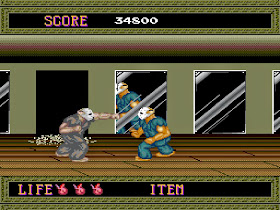Strider (or Strider Hiryu as it is known in Japan) is a hack ‘n’ slash platform
game released into the arcades in 1989.
I acquired it for my Atari ST and like R-Type and OutRun it was a
disappointing conversion. I’m guessing
the same is true of the other European home computer releases as none of them
appear on my shortlist.
The two versions that are on my shortlist are Strider for the Sega Mega Drive from
1990 and Strider Hiryu for the Sharp
X68000 which was released in Japan in 1992.
The X68000 arguably hosts the most faithful conversion of Strider including some nice speech
between stages. The Sega Mega Drive
release has larger sprites, slightly inferior graphics and a different ending
but is equally as playable.
The game is set in the near future – 2048 to be precise –
and the world is ruled by a tyrannical dictator known as the Grandmaster. You
are cast as Hiryu, a member of an order of ninja-like agents known as
Striders. It is your task to fight your
way through the games five stages in order to bring an end to his reign.
The basic aim of the game is to traverse each stage from
left to right. Hiryu is controlled by
the d-pad and two buttons. One button
allows him to jump and the second to attack.
The main means of dispatching enemies is the plasma sword. Pressing down and the jump button
simultaneously makes the character slide to get under obstacles and take out
weaker opponents.
Strider Hiryu is very versatile character. He can climb sheer walls, hang from ledges
and platforms and perform a long cartwheel jump. Each stage has been designed to make
the most of these abilities seeming as tall as they are wide.
Power ups can be found scattered around the stages and are
dropped by certain enemies. These
include increasing the range of the plasma sword, adding to the health bar and providing extra lives. The power ups can also
include robotic helpers. These comprise
an eagle that can dispatch aerial enemies and droids that can take out ground
based opponents. There is also a robotic
tiger that follows Hiryu but didn’t seem to help much. The final power up gives Strider a couple of
short-lived doubles that make him invincible.
Every time Hiryu is hit his health gauge is decreased. When this is depleted he will lose a
life. He can also lose a life if he
falls off the bottom of the screen or when the time limit runs out. When all lives are lost each version contains
a couple of continues.
Although these two games represent the best versions of
Strider at the time, neither is perfect.
Both suffer graphical glitches when the screen gets busy (though not as
glitchy as my example gameplay video). I
also found Strider starts to get very
difficult during the second level, but I guess that’s the nature of the coin-op original. It’s still a great game and
I am finding it difficult to separate the two versions.
Example gameplay from the Sharp X68000 (a combination of my screen recording software and youtube makes the graphics more glitchy than normal (especially at the end))....
 |
| At the end of stage one the Russian Parliament forms into a hammer and sickle wielding centipede (Mega Drive) |
Example gameplay from the Sharp X68000 (a combination of my screen recording software and youtube makes the graphics more glitchy than normal (especially at the end))....







